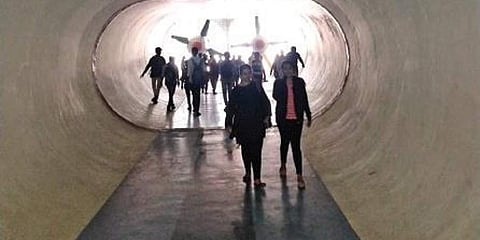

The safety of India’s first astronauts — Gaganauts — who will be on the country’s first-ever manned space flight, rests on the experiments being conducted at the 61-year-old wind tunnel facility at the Indian Institute of Science (IISc) here. The facility is conducting experiments in aerodynamics for India’s first manned space mission ‘Gaganyaan’, and the scientists are checking if the model will behave as per plan during the mission with astronauts in it.
These ‘mission development experimental studies’ will help understand the aerodynamic configuration of all regimes of flight (from launch to landing), and will alert designers if any external design changes are to be made before the prototype launch.
To ensure mission safety, scientists at the Open-Circuit Wind Tunnel facility at IISc, established in 1959, are holding the simulation and experimental studies on the scaled-down flight model. V Surendranath, Principal Research Scientist, Aerodynamics, IISc, told The New Indian Express that each phase in the Gaganyaan mission will be tested separately to its maximum safety limit and the operational capability (of the rocket) will be proven.
The first crucial stage, the ascent, is when the rocket cuts off from from the umbilical tower that stands next to it before launch. The two structures must not crash into each other and hence their interaction is being understood through rigorous tests at the facility.
To study the next ‘cruising’ phase, which is when the rocket moves towards outer space, a six-component strain gauge is used on the model in the wind tunnel to provide aerodynamic force at various cruise angle conditions of the spacecraft. The model is rotated at 45 degrees and tested for the force of the wind that will act on the body of the rocket.
The third stage is when the crew module (capsule where the astronauts live) is separated from the main rocket. The phase is evaluated particularly in terms of crew safety, according to the scientists. And this is critical due to dangers of ‘tumbling motion’, where the module could bump against its parent. In an alternative scenario, a ‘negative axiom force’ can cause the crew module to get sucked back into the parent and crash, scientists said.
“Hence, we are trying to understand and evaluate the interactions between the mother and child (crew module),” they added.
Damp test
Toward the end of the mission, the crew module just drops back into gravity while descending to Earth, and at a certain speed, the parachute opens up. During this phase, it is important that the module does not oscillate. Hence, the disturbance has to be dampened. It is also important that the parachute does not open up in a knotted manner.
The ‘parachute opening dynamics’ are tested at the facility to reach minimum impact, added the scientists, who are running the tests.
